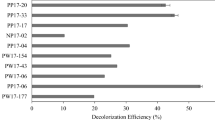Summary
The effluent from bagasse-based pulp and paper mills can be decolorized with the white-rot fungus Schizophyllum commune. The influence of pH, nutrients and aeration on the decolorizing efficiency of this fungus has been determined. It was found that it could not degrade lignin unless a more easily metabolized carbon source was made available simultaneously. The addition of carbon and nitrogen not only improved the decolorizing efficiency of the fungus, but also resulted in reduction of the biological oxygen demand (BOD) and chemical oxygen demand (COD) of effluent. A 2-day incubation period was sufficient for lignin breakdown by S. commune. The efficiency of treatment of effluent with this fungus was highest at pH 4–5 and was further improved by intermittent aeration.
Similar content being viewed by others
References
APHA, AWWA, WPCF (1975) Standard methods for the examination of water and waste water, 14 th edn. American Public Health Association, Washington D.C.
Crawford DL, Sutherland IB (1979) The role of actinomycetes in the development of lignocellulose. Dev Ind Microbiol 20:143
Drew SW, Kadam KL (1979) Lignin metabolism by Aspergillus fumigatus and white-rot fungi. Dev Ind Microbiol 20:153
Dutta SA, Parhad NM, Joshi SR (1985) Decolorization of lignin bearing waste by Aspergillus sp. IAWPC Technol Annu 12:32–37
Eaton D, Chang HM, Kirk TK (1980) Decolorization of kraft blech plant effluents. TAPPI 63:103
Eriksson KF, Grunewald A, Vallander L (1980) Studies of growth conditions for three white-rot fungi and their cellulase mutants. Biotechnol Bioeng 22:363–376
Fukuzumi T (1980) Microbial decolorization and defoaming of pulping waste liquors. In: Kirk TK, Higuchi T, Chang HM (eds) Lignin biodegradation: microbiology, chemistry and potential applications, vol 1, RC Press, Boca Raton, Fla, pp 215–230
Kawakami H (1975). Biodegradation of lignin sulphonates. Water Res Abstr 9:76–05845
Kirk TK (1980) Fungal determination of kraft bleach plant effluents. TAPPI 63:103
Subramanyam PVR, Sachan PC, Mohan Rao GJ (1972) Aspects of colour removal from pulp and paper mill effluents. IPPTA 5:50–60
Thomas W, Chang HM, Alton G, Eaton D, Kirk K (1981) Removal of kraft bleach plant colour by a ligninolytic fungus. Proceedings of the Applied Environmental Conference, USA, pp 225–228
Westermark A, Kirkson E (1974) Cellobiose: quinone oxidoreductase, a new wood degrading enzyme from white-rot fungi. Acta Chem Scand [B] 28:209–214
Author information
Authors and Affiliations
Rights and permissions
About this article
Cite this article
Belsare, D.K., Prasad, D.Y. Decolorization of effluent from the bagasse-based pulp mills by white-rot fungus, Schizophyllum commune . Appl Microbiol Biotechnol 28, 301–304 (1988). https://doi.org/10.1007/BF00250460
Received:
Accepted:
Issue Date:
DOI: https://doi.org/10.1007/BF00250460




